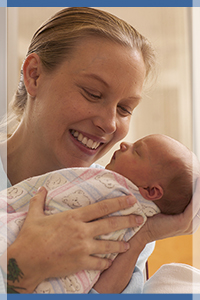New Mom & Baby Health

This section provides information for new moms. If you have any questions concerning our services, please refer to our Contact Us page.
After Childbirth
It is normal to feel excited, tired, and amazed all at the same time after delivery. You may feel a great sense of calm, peace, and relief as you hold, look at, and talk to your baby. During the first hour after the birth, you can also expect to introduce your baby to feeding by breast, if you plan to breast-feed.
Breast-feeding
Breast-feeding provides significant health benefits to both you and your baby and is strongly encouraged by the American Academy of Pediatrics.11 If you breast-feed, don't be surprised if you and your baby have some difficulty at first. Breast-feeding is a learned technique—you will get better at it with practice. Almost all difficulties that can develop with breast-feeding can be remedied with home treatments and by talking to your health professional or a breast-feeding specialist (lactation consultant). Most hospitals have at least one lactation consultant available to help new mothers breast-feed. Don't hesitate to ask for help.
During the first days of breast-feeding, your nipples will probably become tender or sore and may even develop painful cracks in the skin. But as breast-feeding becomes more established, the soreness usually goes away. For more information, see the topic Breast-Feeding.
For helpful information about getting a good start with breast-feeding and preventing complications, see:
Your first hours of recovery
You may experience shaking chills right after delivery. This is a common reaction in the hours after delivery. A warm blanket may help you feel more comfortable.
During the first hours after the birth, your health professional or a nurse will:
- Massage your uterus by rubbing your lower abdomen about every 15 minutes. Later, you will be taught to massage your own uterus. This helps it tighten (contract) and stop bleeding. If your uterus does not contract (boggy uterus), it may bleed too much, or hemorrhage. (When hemorrhage occurs, medication is used to slow the bleeding, and the uterus is checked for placenta that hasn't detached, a common cause of heavy bleeding. You'll also be checked for tears in the cervix and vagina, which can lead to hemorrhage. In severe cases, surgery is used to stop bleeding, and fluid and blood transfusions are used to prevent shock and blood loss.)
- Check your bladder to make sure it isn't full. A full bladder puts pressure on your uterus, which interferes with contractions. You will be asked to try to urinate, which may be difficult because of pain and swelling. If you cannot urinate, a tube (catheter) can be used to empty your bladder. Difficulty urinating usually passes quickly.
- Check your blood pressure frequently for several hours.
- Repair the area between your vagina and anus (perineum) if it tore or you had an incision (episiotomy).
- Remove the small tube in your back (epidural catheter) if you had epidural anesthesia. If you plan to have a tubal ligation surgery to prevent future pregnancy, the catheter will be left in.

